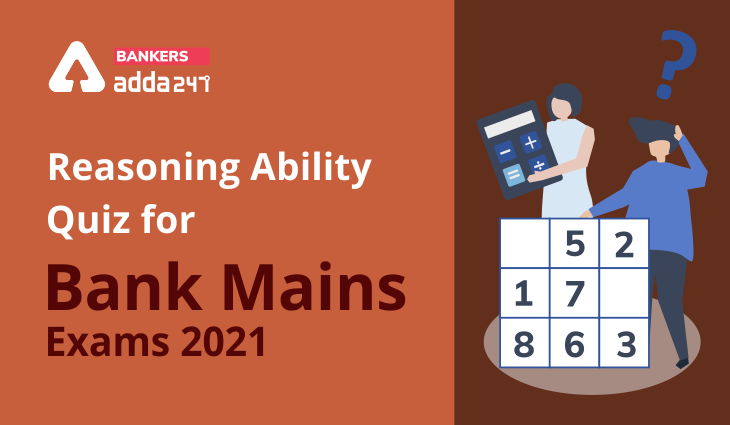Directions (1-5): Study the given information and answer the questions:
Eight persons A, B, C, D, E, F, G and H are sitting in a straight line. Some of them are facing towards north direction while some of them are facing towards south direction. They all like different characters of Harry potter movie viz Minerva, Horace, Pomona, Marcus, Seamus, Angelina, Pancy and Alicia but not necessarily in the same order.
A likes Marcus and sits third from one of the extreme end of line. There are three persons sit between A and H, who likes Horace. H does not sit any of the extreme end of the line. G sits second to right of H. B likes Seamus and sits third to right of F, who likes Minerva and B is not an immediate neighbour of H. C does not like Angelina. E does not like Pancy. B does not sit any of the extreme end of the line. There are as many as persons sit between C and the one who likes Pomona and as between D and the one who likes Pomona. F faces south. D neither likes Pancy nor Angelina. Immediate neighbor of H faces same direction as of H. C sits one of the extreme end of line. G sits second to right of A, and both faces same direction. B sits second to right of D and both faces opposite direction.
Q1. Who among following sits extreme end of the line?
(a) C,F
(b) G,A
(c) F,B
(d) E,D
(e) Cannot be determined
Q2. Who among following sits third to right of C?
(a) D
(b) H
(c) A
(d) F
(e) None of these
Q3. Who among following sits exactly between D and B?
(a) E
(b) A
(c) F
(d) H
(e) None of these
Q4. Who among following likes Alicia?
(a) G
(b) B
(c) A
(d) D
(e) F
Q5. Who among following sits third to left one who likes Pomona?
(a) The one who likes Seamus
(b) The one who likes Marcus
(c) The one who likes Alicia
(d) The one who likes Pancy
(e) None of these.
Directions (6-10): In the following questions, the symbols $, @, %, & and # are used with the following meanings as illustrated below:
‘A $ B’ means A is neither greater nor smaller than B
‘A @ B’ means A is neither greater than nor equal to B
`A % B’ means A is neither smaller than nor equal to B
‘A & B’ means A is not smaller than B
‘A # B’ means A is not greater than B
In each of the following questions, assuming the given statements to be true, find out which of the two conclusions I and II given below them is/are definitely true. Give answer
Q6.Statements:
W & P, P % G, G @ I, I # N
Conclusions:
I. N % W
II. N # W
(a) if only conclusion I is true.
(b) if only conclusion II is true.
(c) if either conclusion I or II is true.
(d) if neither conclusion I nor II is true.
(e) if both conclusions I and II are true.
Q7.Statements:
U @ D, D $ E, E % Y, Y& W
Conclusions:
I. U @ Y
II. W %D
(a) if only conclusion I is true.
(b) if only conclusion II is true.
(c) if either conclusion I or II is true.
(d) if neither conclusion I nor II is true.
(e) if both conclusions I and II are true.
Q8.Statements:
Z % N, N # K, K $ M, M @ R
Conclusions:
I. M $ N
II. M % N
(a) if only conclusion I is true.
(b) if only conclusion II is true.
(c) if either conclusion I or II is true.
(d) if neither conclusion I nor II is true.
(e) if both conclusions I and II are true.
Q9.Statements:
V & D, D %T, K $ T, K # F
Conclusions:
I. V % F
II. V % K
(a) if only conclusion I is true.
(b) if only conclusion II is true.
(c) if either conclusion I or II is true.
(d) if neither conclusion I nor II is true.
(e) if both conclusions I and II are true.
Q10.Statements:
S $ Q, Q @ B, B &K, K # W
Conclusions:
I. W % K
II. S @ B
(a) if only conclusion I is true.
(b) if only conclusion II is true.
(c) if either conclusion I or II is true.
(d) if neither conclusion I nor II is true.
(e) if both conclusions I and II are true.
Directions (11-13): In making decisions about important questions, it is desirable to be able to distinguish between strong arguments and weak arguments in so far as they relate to the question. Strong arguments are those which are both important and directly related to the question. Weak arguments are those which are of minor importance and also may not be directly related to the question or may be related to a trivial aspect of the question
Each question below is followed by two arguments numbered I and II. You have to decide which of the arguments is a strong argument and which is a weak argument.
Give answer
Q11. Statements should the public sector undertakings be allowed to adopt hire-and-fire policy?
Arguments
I. Yes. This will help the public sector undertakings to get rid of non-performing employees and will also help to reward the performing employees.
II. No, the management may not be able to implement the policy in an unbiased manner and the employees will suffer due to the high-handedness of the management.
(a) if only argument I is strong
(b) if only argument II is strong
(c) If either I or II is strong
(d) If neither I nor II is strong
(e) If both I and II are strong
Q12. Statement Should one close relative of a retiring government employee be given a job in government in India?
Argument
I. Yes, where else will the relative get a job like this?
II. No, it will close doors of government service to competent and needy youth.
(a) if only argument I is strong
(b) if only argument II is strong
(c) If either I or II is strong
(d) If neither I nor II is strong
(e) If both I and II are strong
Q13. Statement Should the term of the elected members of parliament be reduced to two years in India?
Arguments
I. Yes, even otherwise the election are generally held every alternate year in India
II. No, every round of parliament election needs huge amount of money and it’s a national waste.
(a) if only argument I is strong
(b) if only argument II is strong
(c) If either I or II is strong
(d) If neither I nor II is strong
(e) If both I and II are strong
Q14. How many words can be formed from the 3rd, 4th, 7th and 9th letter of a word ‘GENERATION’ by using each letter once in the word?
(a) One
(b) Three
(c) Four
(d) Two
(e) None
Q15. If in the number 86143279, 1 is added to each of the digit which is less than five and 1 is subtracted from each of the digit which is greater than five then how many digits are repeating in the number thus formed?
(a) two
(b) one
(c) none
(d) three
(e) four
Practice More Questions of Reasoning for Competitive Exams:
Solutions


S11. Ans.(a)
Sol. Argument I is strong because it will increase the efficiency and productivity of public sector undertakings. Argument II is not strong because it is based on wrong notion.
S12. Ans.(b)
Sol. Argument I is not strong because we cannot change the system for one individual. Argument II is strong because needy youths would not get government job.
S13. Ans.(b)
Sol. Argument I is not strong because there is not a strong logic behind it. Argument II is strong because in a country where fiscal deficit is of paramount concern, money spent on elections is national waste.
S14. Ans.(d)
Sol. TONE, NOTE
S15.Ans.(b)
Practice with Online Test Series for Bank Mains 2021:
Click Here to Register for Bank Exams 2020 Preparation Material




 GA Capsule for SBI Clerk Mains 2025, Dow...
GA Capsule for SBI Clerk Mains 2025, Dow...
 The Hindu Review October 2022: Download ...
The Hindu Review October 2022: Download ...
 Bank Exams 2025, Check Full List of Upco...
Bank Exams 2025, Check Full List of Upco...


